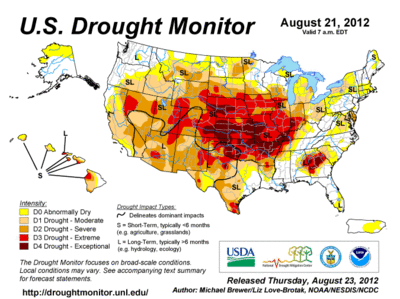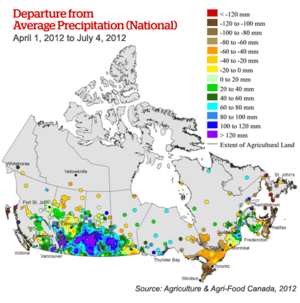2012–15 North American drought

The 2012–15 North American Drought, an expansion of the 2010–13 Southern United States drought, originated in the midst of a record-breaking heat wave. Low snowfall amounts in winter, coupled with the intense summer heat from La Niña, caused drought-like conditions to migrate northward from the southern United States, wreaking havoc on crops and water supply.[1] The drought has inflicted, and is expected to continue to inflict, catastrophic economic ramifications for the affected states. It has exceeded, in most measures, the 1988-1989 North American drought, the most recent comparable drought, and is on track to exceed that drought as the costliest natural disaster in US history.[2]
The drought includes most of the US, parts of Mexico, and central and Eastern Canada. At its peak on July 17, 2012, it covered approximately 81 percent of the contiguous United States with at least abnormally dry (D0) conditions. Out of that 81%, 64% was designated as at least moderate drought (D1) conditions.[3] Its area was comparable to the droughts in the 1930s and 1950s but it has not yet been in place for as long.[4] In March 2013, heavy winter rains broke a three-year pattern of drought in much of the Southeastern United States, while drought conditions still plague the Great Plains and other parts of the US, according to the U.S. Drought Monitor.[5]
Drought continued in parts of North America through 2013.[6] Beginning in March 2013, improved rainfall across the Midwest, southern Mississippi Valley, and Great Plains began gradually alleviating drought in these areas, while drought continued to intensify in the Western United States. Heavy rains across previously drought-stricken areas resulted in widespread flooding in portions of the Midwest, a phenomenon which was named "weather whiplash".[7] By June 2013, approximately the eastern half of the United States was drought-free, while conditions continued to gradually improve across the Plains. Moderate to severe drought continues to impact and worsen throughout the western United States, with some portions of the United States being afflicted by the drought for over three years. Through the winter of 2013-2014, California continued to receive record low rainfall.[8] For many locations, the calendar year of 2013 was the driest year in over 130 years. Some locations received less than half of their previous record low rainfall amounts.[9]
Meteorological background


The drought was set in motion when strongly positive Arctic oscillation and North Atlantic oscillation conditions removed winter storms from the U.S. the winter of 2011–2012.[10] When spring arrived, very little snow existed to melt and moisten the ground, and thus very little water to evaporate and create rainfall. The effects of the lack of snow were immediate. Dry conditions could be noticed immediately, and contributed to a weak tornado season in the US.[11] The strongest tornado outbreak of 2012 occurred on March 2, after most snow had melted.[12] The drought continued to steadily intensify along with a decline in rainfall which is still ongoing. The Summer 2012 North American heat wave caused further evaporation of groundwater, lakes, reservoirs, and rivers and streams.[13]
As moisture has continued to decline, the conditions are becoming self-sustaining (i.e. a lack of rainfall means that less moisture is available to promote additional rainfall, in a vicious cycle).[14] In many areas, the only way for drought conditions to be significantly alleviated in the short-term would be for a discrete, long-lived, and large system (such as a tropical cyclone) to impact the area.[15] Soil hardening due to the drought means that even if a large amount of rain falls in a short time, most of it will run off quickly causing flash floods rather than drought relief. The June 2012 North American derecho and other strong storms in late June and early July did not appear to ease drought conditions, as the rainwater ran off rapidly from the affected areas.
The drought is expected to continue and possibly intensify into the end of November 2014 for a large part of the country. Although drought/dry conditions are likely to drop at least one category level in the Southwest, Southeast, Northeast, and Northern Plains as well as portions of the Ohio River Valley, it is expected to have both short-term and long-term impacts across nearly the entire affected area.[3][16]

Impacts
United States

The drought has cost more than $35 billion in the Midwest, and is predicted to reduce the gross domestic product by 0.5-1% of the US as a whole, equating to a loss of $75 to $150 billion.[17]
Crops, particularly strains grown in the most heavily affected regions (such as corn and soybeans), have been noted to be failing or yielding very low this year due to the drought's presence in farming areas.[18] This increase in cost will most likely move up the feeding chain and result in raised prices for meat, dairy, and processed food products.Food prices are expected to rise dramatically because the resulting supply shortfall.[19][20] The price of farm equipment, on the other hand, is expected to decrease as farmers are forced to sell off their equipment and machinery to cope with decreased incomes.[21]
Parts of the Mississippi water levels have plummeted, affecting trade and commerce.[22]
1,692 counties across 36 states in the US have been legally declared primary natural disaster areas as of August 17 as the drought continues to cover 62% of the contiguous US.[23] Hundreds of additional counties bordering the primary disaster areas are designated as "contiguous" disaster areas, and are also eligible for federal aid.
The number of cattle in the US has been decreased to the lowest in 60 years due to drought impacts, with 69% of cattle located in areas currently facing drought conditions.[24][25]
Canada
The drought affects Canada mainly in the east in Ontario, Quebec and the Atlantic provinces where there has been record setting heat and very little rainfall.[26] Summer crops in these areas have been affected and the price of produce is expected to increase, particularly corn and soybean.[27][28]
See also
Concurrent and related weather events
- March 2012 North American heat wave
- Summer 2012 North American heat wave
- June 2012 North American derecho
- 2012 Oklahoma wildfires
- 2012 Colorado wildfires
- Climate change in California
- 2013 California wildfires
- 2014 California wildfires
Other widespread severe droughts
- Dust Bowl
- 1950s North American drought
- 1988 North American drought
References
- ↑ Freedman, Andrew (21 July 2012). "Causes Of Midwest Drought: La Nina And Global Warming Thought To Contribute To Dry Weather". Huffington Post. Retrieved 14 January 2013.
- ↑ Kimery, Anthony (January 6, 2012). "FEMA - Dealing with the Drought". Homeland Security Today. Retrieved 2012-08-24.
- ↑ 3.0 3.1 "United States Drought Monitor > Home". Droughtmonitor.unl.edu. Retrieved 2014-03-03.
- ↑ Parry, Wynne (19 July 2012). "How Bad Is the US Drought?". LiveScience (Yahoo! News). Retrieved 19 July 2012.
- ↑ Rains Bring Relief to Region; Winter Weather Reduces Drought in Southeast, Southwest; Other Areas Still Threatened March 12, 2013 WSJ
- ↑ Thin Snowpack in West Signals Summer of Drought February 22, 2013 NYT
- ↑ "As Drought Turns To Flood, Farmers Get 'Weather Whiplash' : The Salt". NPR. 2013-06-12. Retrieved 2014-03-03.
- ↑ Becerra, Hector (September 25, 2014) "Drought has 14 communities on the brink of waterlessness" Los Angeles Times
- ↑ In Midwest, Drought Gives Way to Flood April 25, 2013 New York Times
- ↑ "So far, Arctic Oscillation favoring mild winter for eastern U.S.". Climate.gov. 21 December 2011. Retrieved 17 September 2014.
- ↑ Freedman, Andrew (28 July 2012). "Tornado Season 2012: Record-Low Twister Count Is Drought's Silver Lining". The Huffington Post. Retrieved 14 January 2013.
- ↑ Samenow, Jason (5 March 2012). "Tornado outbreak: recap of deadly March 2 storms in Tennessee and Ohio Valley, South". The Washington Post. Retrieved 14 January 2013.
- ↑ Freedman, Andrew (9 July 2012). "2012 Heat Wave is Historic, if not Unprecedented". Climate Central. Retrieved 14 January 2013.
- ↑ Painter, Bryan (7 August 2011). "Dryness, heat make for vicious cycle". NewsOK. Retrieved 14 January 2013.
- ↑ "Drought Termination and Amelioration". National Climatic Data Center. Retrieved 14 January 2013.
- ↑ "United States Drought Information". Climate Prediction Center. Retrieved 17 September 2014.
- ↑ Masters, Jeff. "Dr.". Weather Underground. Retrieved 13 January 2013.
- ↑ Crutchfield, Steve. "U.S. Drought 2012: Farm and Food Impacts". USDA ERS. Retrieved 13 January 2013.
- ↑ Drought Stalks the Global Food Supply, Business Week July 5, 2012
- ↑ Severe Drought Seen as Driving Cost of Food Up July 25, 2012 New York Times
- ↑ World Magazine "Our Parched Land" August 11, 2012 Daniel James Devine (author)
- ↑ MCWHIRTER, Cameroon (13 July 2013). "Trade Dries Up Along With Mississippi". Wall Street Journal. Retrieved 19 July 2012.
- ↑ APAugust 1, 2012, 8:36 PM (2012-08-01). "U.S. drought: Half of all counties disaster areas". CBS News. Retrieved 2014-03-03.
- ↑ Drought Drives Down Cattle Count February 1, 2013 WSJ
- ↑ Drought on the Range: Tough Times for U.S. Cattle Herd - 2013 April 11, 2013 (Video) New York Times
- ↑ http://www.cbc.ca/news/business/story/2012/07/20/crop-prices-drought-canada-us.html CBC.ca
- ↑ "Record crop prices spur food-crisis worries - Business - CBC News". Cbc.ca. 2012-07-20. Retrieved 2014-03-03.
- ↑ Drying times; The 2012 drought will dent farm profits and push up food prices July 21st 2012 The Economist